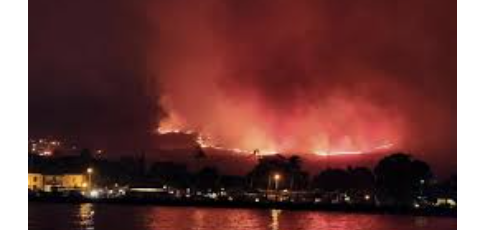By Katharine M. Nohr, J.D.
Lee Cataluna, a beloved Hawaii playwright and journalist wrote, “the people I want to write for won’t read this. They’re busy grieving. They’re busy trying to figure out how to make sense of what happened, to think about what happens next, to remember how to take the next breath—all those basic things that become so hard when life turns in an instant and everything you counted on is gone.” She was referencing the devastating apocalyptic wildfires that obliterated historic Lahaina, Maui, leaving residents, pets in tow, fleeing—many of them not making it out alive.
IAIP members and the world view images of the horrific scenes of utter destruction and want to wrap their collective arms around the island of Maui and comfort the charred land and its heartbroken people. As insurance professionals we are accustomed to responding to disasters because that’s the very heart of our industry. However, this disaster is particularly tragic. It has forever destroyed Lahaina with over a thousand years of rich history, the capital of the Kingdom of Hawaii from 1820 to 1845 that is revered by Native Hawaiians.
As displaced residents try to survive without homes or jobs, grapple with the death of family members, dear friends, and pets, how can they begin to put their lives together? As insurance professionals, we can offer our deepest sympathy, make donations of money, time and needed supplies, and we can also offer some guidance as to what they need to do to obtain much-needed insurance moneys. Hopefully, those insurance companies who insure homes and businesses on Maui are identifying those structures that likely have been damaged or destroyed so that they can assist in making the claims process as seamless as possible.
Filing an insurance claim after a home or business fire can be time consuming and stressful—especially for those in Lahaina who may not have access to a computer, phone, and no longer have an address. While the specific steps and requirements may vary depending on the insurance company, the applicable policy, and local regulations, here’s a general guideline to help those suffering loss in the Maui fire navigate the process:
Notify your insurance company: Contact your insurance agent or the company’s claims hotline. Provide basic details, and they’ll guide you on the next steps and what information they need.
Document the damage when you are able to safely enter your property:
Take photos and videos: Before any clean-up or repairs begin, thoroughly document the damage. This can help during the claim process.
List damaged items: Make an inventory of all damaged personal property. Include a description, date of purchase, estimated value, and any receipts if available.
Secure the property: To prevent further damage to those structures that still remain standing (and potential complications with your claim), you might need to:
Board up any broken windows or doors.
Cover damaged roofs or walls with tarps.
Address water damage if any firefighting efforts led to flooding.
These steps may be difficult in Lahaina due to government prohibitions allowing people to enter their property.
Gather necessary documentation:
Policy number: If possible, have your insurance policy number ready when you contact your insurance company.
Fire report: Ordinarily, obtaining a copy of the fire report from the local fire department is requested to provide details about the incident. Since the Maui fires are much documented in the news, this shouldn’t be necessary.
Receipts: If you need to make immediate repairs or buy essentials, keep the receipts. Some policies may cover these emergency costs.
Meet with the adjuster: Your insurance company will send an adjuster to inspect the damage. They’ll evaluate the loss and determine the compensation amount based on your policy’s coverage. Be present during this inspection and provide any information they might need.
Review your policy: You’ll likely need to request a copy of your policy. Understand what’s covered and what’s not. This includes understanding your policy’s limits, deductibles, and any additional coverage (like temporary living expenses).
Submit a proof of loss statement: This is a formal document where you state the value of the items you’re claiming as lost or damaged. Your insurance company will provide this form, and it must be filled out, signed, and returned within a specified time frame.
Keep communication open: Stay in touch with your insurance company throughout the claims process. Address any questions or concerns promptly.
Consider professional help: In complex cases or if you feel the settlement offer is inadequate, you might want to hire a public adjuster or attorney to help navigate the process and negotiate on your behalf.
Receive payment: Once the claim is settled, your insurance company will provide compensation for the damages. Understand that if you have a mortgage on the property, the payment might be made jointly to you and your mortgage lender.
Start the restoration process: After settling the claim, you can commence with the restoration or rebuilding process.
Remember, insurance policies and procedures can vary, so always refer to your specific policy and discuss any concerns with your insurance agent or company.
Recovery of lives and property and mending of land and hearts will take years. Hopefully, the insurance claim process will be efficient and painless with the assistance of efficient, kind, and knowledgeable insurance professionals and insurance companies that seek to provide fair and quick compensation.
Katharine M. Nohr, J.D. has been a member of IAIP since 2002. She has served as president of the Honolulu Association of Insurance Professionals (HAIP), Hawaii State Council Director, RVP of Region VIII, and has served on many IAIP committees and task forces. She is an insurance defense attorney in Hawaii.
